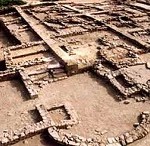In 2012, a group of businessmen from Ahmedabad put together a plan called The Harappan Civilization. The plan envisioned a World Heritage Site, on the lines of Angkor Wat, which spanned the entire Harappan civilisation of the states of Sindh and Gujarat.
This would be located in Dholavira, that ancient Harappan city situated in Khadir Island in the Rann of Kutch Lake, whose western edge borders Sindh. The plan included restoration of the ruins and a world-class museum with official artefacts that would reflect the history of the civilisation. It was to be a joint Gujarat-Sindh venture, with assistance from UNESCO’s World Heritage Sites and experts from museums around the world like the Smithsonian in the U.S. A board was created, with such experts on it, and an initial study conducted, which put the cost at $3 million for the project.
“It was planned as a transformational project for our shared history, and for better relations between India and Pakistan,” Sunil Parekh, an Ahmedabad-based consultant and one of the initiators of the project, said (in a personal interview).
It is a bold-thinking, state-to-state joint effort that can promote the shared history of the two states. The project brings together people, history, and the private sector within a confined environment, away from government and bureaucratic interference from both sides.
A year later, the project was put on hold, a casualty of nativist politics.
The old, and deep linkages between Bombay and Karachi are also worth exploring. The British invested in these two port cities, and built them into the grand cities of Asia. Nearly 70 years after Napier sailed away from Karachi, a city he entered on a ship built in Bombay, both cities are in decline. Can an economic engagement between these two metropolises of South Asia help to revive their fortunes, and those of the region?
These are ambitious thoughts, and worth exploring. Many attempts have been made over the years, with little success. Still, the efforts continue, and this paper is one such effort, with recommendations to take small, realistic steps forward, given the constraints, to prepare for the larger engagement of the India-Pakistan bilateral.
You can download the PDF version of this report, here.
S. Akbar Zaidi is visiting professor, Columbia University.
Manjeet Kripalani is the co-founder and executive director of Gateway House: Indian Council on Global Relations, Mumbai.
This is a joint report by Gateway House: Indian Council on Global Relations, Mumbai, and the Centre for Policy Research, New Delhi. You can read more exclusive content here.
For interview requests with the author, or for permission to republish, please contact outreach@gatewayhouse.in.
©Copyright 2014 Gateway House: Indian Council on Global Relations. All rights reserved. Any unauthorized copying or reproduction is strictly prohibited.


